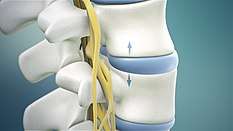Spinal decompression
Spinal decompression is a surgical procedure intended to relieve pressure on the spinal cord or on one or more compressed nerve roots passing through or exiting the spinal column.[1] Decompression of the spinal neural elements is a key component in treating spinal radiculopathy, myelopathy and claudication.

Decompression of nerve roots
When a single spinal nerve root is compressed, the resulting clinical outcome is termed radiculopathy, and is usually labeled according to the specific nerve root compressed (hence compression of the nerve root exiting the spinal column below the left-sided pedicle of the L5 vertebra will be diagnosed as “left L5 radiculopathy”).
Microdiscectomy (or microdecompression) is a minimally invasive surgical procedure in which a portion of a herniated nucleus pulposus is removed by way of a surgical instrument.[2] The purpose of this procedure is to relieve the pressure and reduce the local inflammatory reaction around a nerve root, caused by the herniated nucleus pulposus.
Decompression of the spinal cord or cauda equina
Laminectomy is an open or minimally invasive surgical procedure in which a portion of the posterior arch of the vertebrae and/or spinal ligaments is removed from the spine to alleviate the pressure on the spinal canal contents. This procedure is usually performed when decompression of more than one nerve root is needed. In the lumbar spine it is commonly used to treat spinal claudication caused by spinal stenosis, and is considered the most effective treatment for this condition based on current evidence.[3] In the cervical and thoracic spine it is used to treat myelopathy caused by compression of the spinal cord itself.
See also
References
- Spinal Stenosis~treatment at eMedicine
- "Back and Leg Pain - Definition List | Resources | HJD Spine Center". Med.nyu.edu. Archived from the original on 25 August 2010. Retrieved 18 December 2010.
- Weinstein, James N.; Tosteson, Tor D.; Lurie, Jon D.; Tosteson, Anna N.A.; Blood, Emily; Hanscom, Brett; Herkowitz, Harry; Cammisa, Frank; Albert, Todd; Boden, Scott D.; Hilibrand, Alan; Goldberg, Harley; Berven, Sigurd; An, Howard (2008). "Surgical versus Nonsurgical Therapy for Lumbar Spinal Stenosis". New England Journal of Medicine. 358 (8): 794–810. doi:10.1056/NEJMoa0707136. PMC 2576513. PMID 18287602.